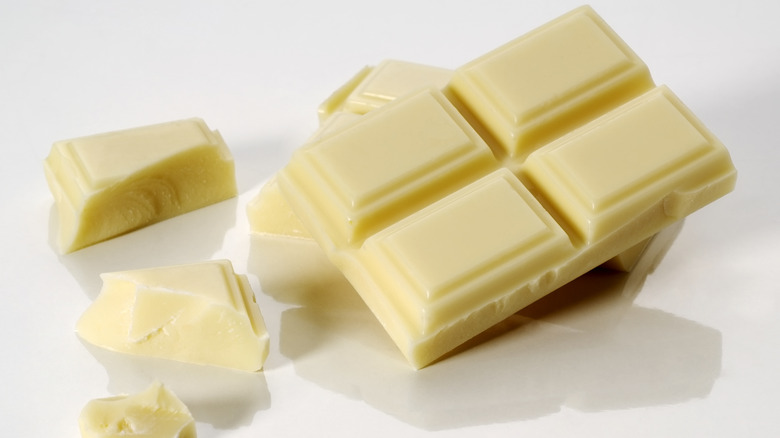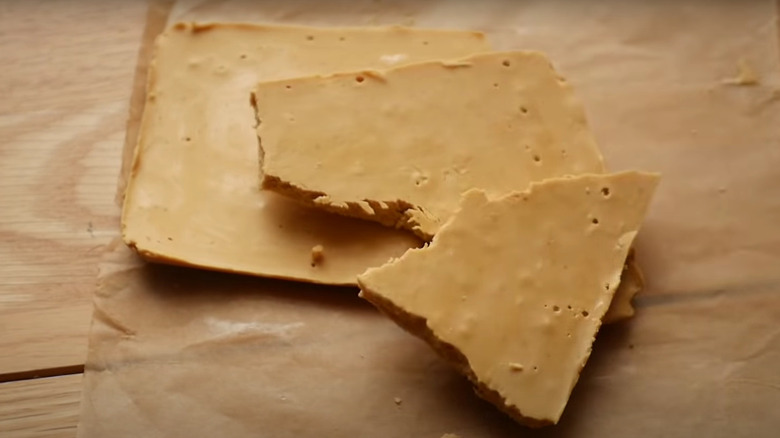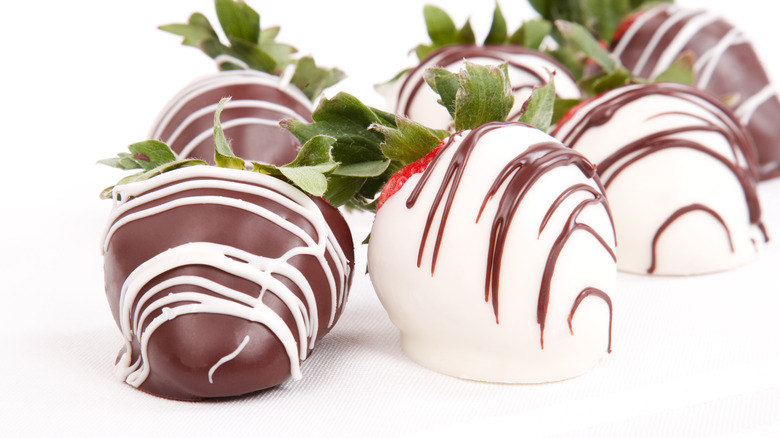What Is The Difference Between Blonde And White Chocolate?
Roaming between white, cream, ivory, and light pastel-yellow colors are the two luscious light-toned chocolates we love identify as white chocolate and blonde chocolate. Truth is, they're basically two incarnations of the same confection. The more commonly known white and its blonde counterpart differ only by a crucial extra step, one that involves the dreamy, lip-smacking addition of caramelization.
Neither is actually "real" chocolate since the chocolatier uses cocoa butter instead of cocoa solids, but those creamy compatriots have avid fans who couldn't care less. The two still derive from cocoa, a product of the Theobroma cacao trees. White chocolate is the mother base from which blonde chocolate evolves. Cocoa butter, milk solids, sugar, and sometimes vanilla blend to create a genuine white chocolate, which turns into the blonde version when it cooks longer at low temperatures.
When cooked low and slow, the sugar and milk solids in white chocolate caramelize, resulting in extra flavor complexity and rich deliciousness for the new blondie. Both white and blonde chocolates can be eaten alone, mixed into candy bars, or baked into all kinds of desserts. Just keep in mind the differing taste tones and extra depth when substituting blonde for white in recipes.
Flavor and quality of white and blonde chocolates
While white chocolate, made from the buttery fat of the cacao seed, is definitively light and sweet, the more recent blonde incarnation dives deeper on the flavor scale. It's common to find nutty, toasty tones of caramel, toffee, or even butterscotch, depending on the chocolatier and on the pureness of ingredients in the white chocolate from which it originated.
It's possible to purchase blonde chocolates ready to eat or to blend into recipes, though they're harder to find in standard retail outlets. No worries — you can make your own using high-quality white chocolate containing roughly 30% cocoa butter and 10% milk solids. You'll be looking for white chocolate chunks in the baking aisle, not the white chocolate chips or flakes. Then it comes down to the same process as professional confectioners –– roasting, toasting, and stirring the white chocolate as it caramelizes into golden blonde goodness. Just be sure you're getting a quality white chocolate bar if you make it yourself — avoid bars with low or no actual cocoa butter. These low-quality white chocolates are less likely to evolve into suitable blonde chocolates, especially if there's no cocoa butter in the mix at all.
Cooking with the two light-toned chocolates
White chocolate dessert recipes abound, and they're easily adaptable for blonde versions. In fact, blonde chocolate transforms treats such as tarts, shortbreads, truffles, and mousses, giving them the flavor depth of caramel while still retaining desired sweetness levels. It's also an excellent complement to nut-based desserts such as macadamia cookies – where every bite is an explosion of crunchy, sweet, and nutty flavors. The same goes for double chocolate versions of chocolate bark with salted almonds.
Both white and blonde chocolates thrive in hot chocolate drinks, with the addition of milk and a touch of salt. The toasty characteristics of a steamy white-chocolate version match with toppings like roasted marshmallows or toasted coconut. The two types of chocolate are also interchangeable when shaved for pie or cupcake decorations, or — if the chocolate is tempered – for creating white chocolate-covered strawberries. And they're both a good balance for shaved toppings over fruit-glazed cheesecakes or flans. Again, the blonde version creates a fuller flavor profile.
As if all that tastiness weren't enough, there's yet another version known as Swiss-style blonde chocolate. Though similar in style and taste to the standard one, the iteration popular in Switzerland takes things a step further. Using even higher quality, purer ingredients, the makers crank up heat temperatures during processing, resulting in even more intense caramelization and deeper color tones.



